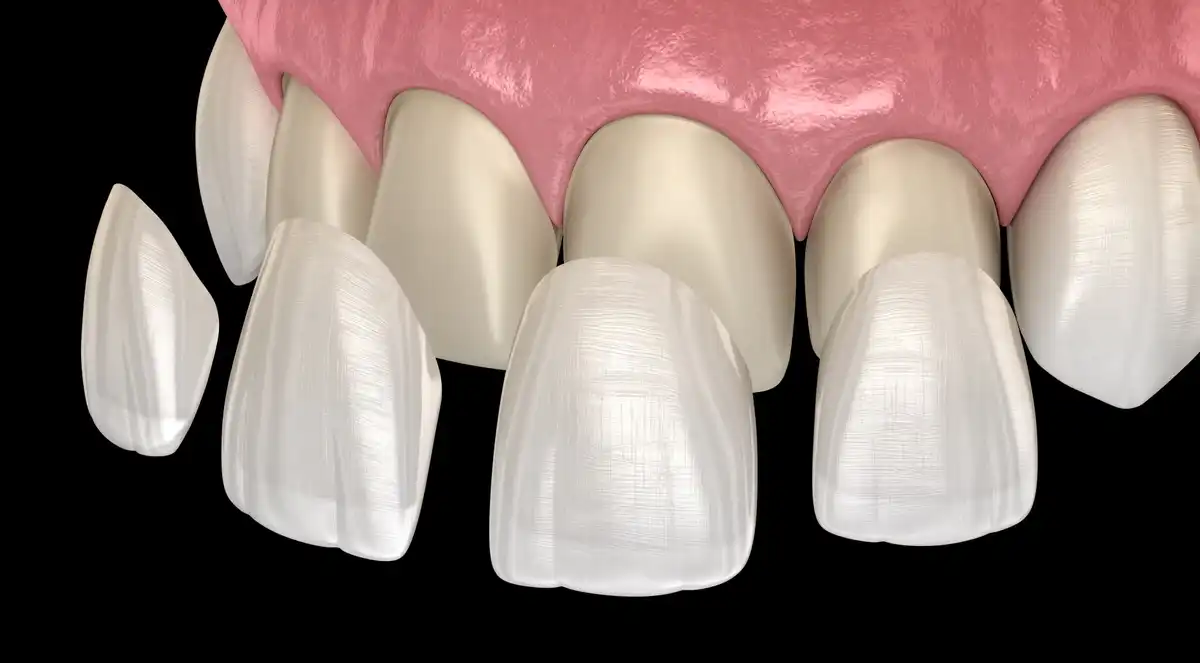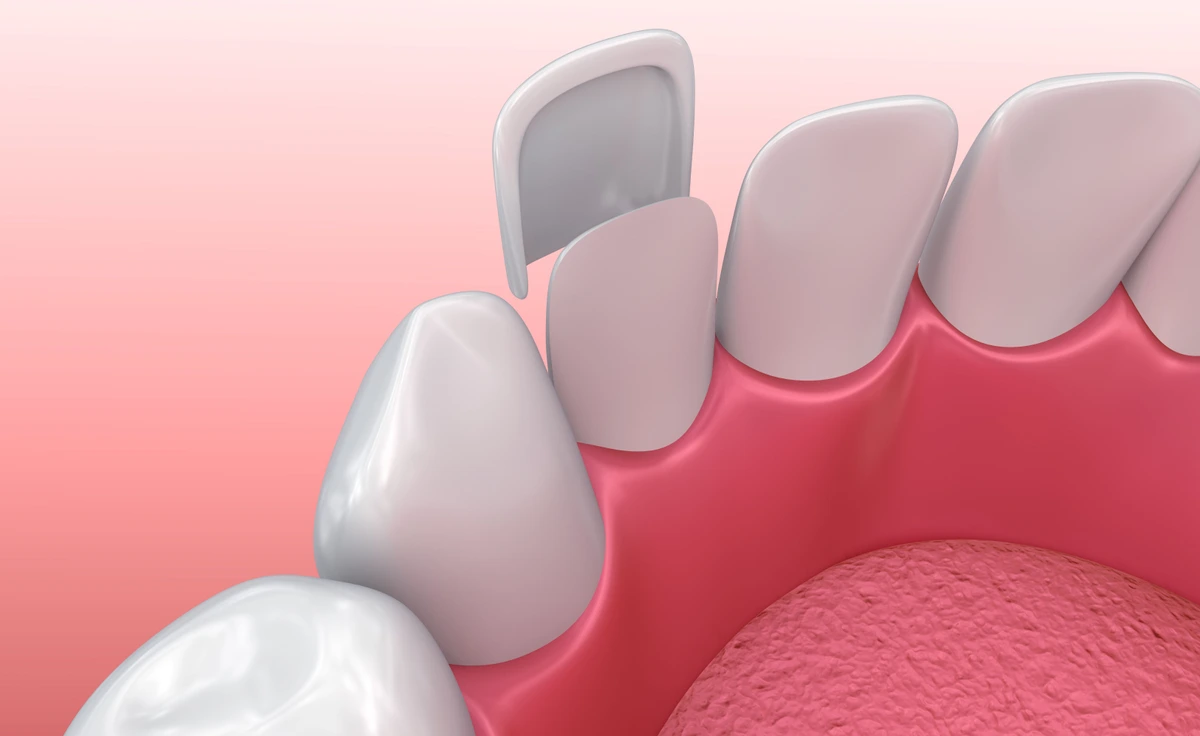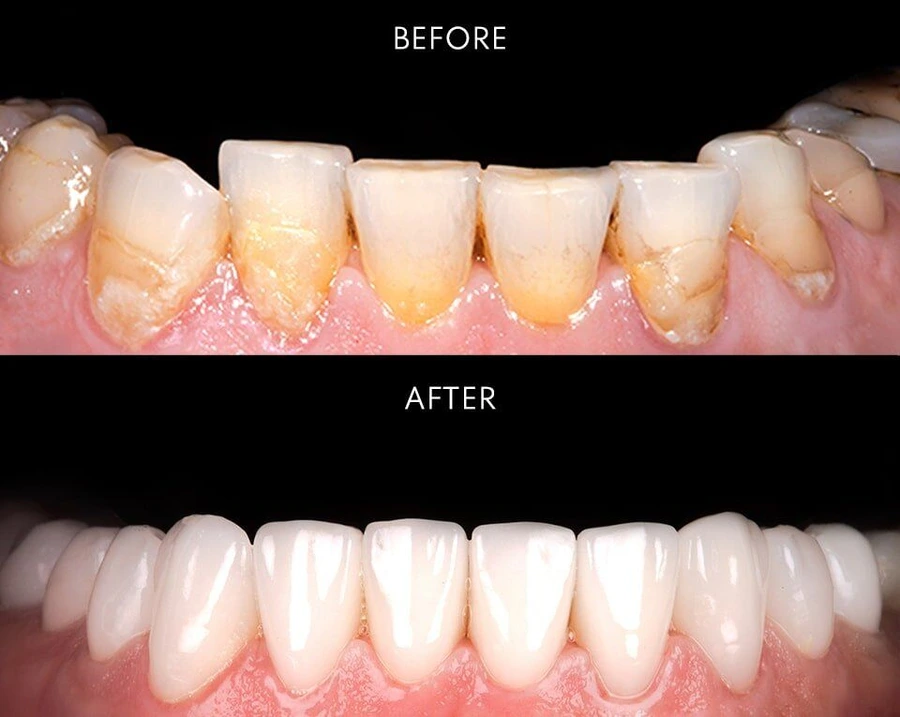What Are Dental Veneers & How Do They Work?


Dental veneers are typically seen as a “go big or go home” solution for the modern smile makeover. These cosmetic restorations are specifically designed to make your smile look whiter, straighter, and more attractive in just a couple of appointments. Depending on the type of restoration you choose, things like veneer cost and the type of dental veneer procedure can vary. Some veneers can be completed in as quickly as one appointment, while others require a few weeks of planning and prep work.
What Are Dental Veneers?
The point of a dental veneer procedure is to mask unattractive healthy teeth, transforming them into a smile you’ve individually designed with the help of your dentist. Veneers don’t repair or reinforce broken teeth, worn teeth, but they do improve the appearance of teeth that are structurally sound and intact. They’re not made to treat areas of active tooth decay or severely worn/broken teeth. Veneers are only for aesthetic purposes.
Why Would I Need Veneers?
Cosmetic veneers quickly enhance the way your overall smile looks. Investing in attractive-looking teeth can help you feel more confident, comfortable, and able to make a great impression around new people.
Aesthetic treatments like veneers work best on teeth at are generally healthy, but not as attractive as you’d like them to be. Since the veneer treatment is fairly quick (it can be completed in just one or two visits, depending on the type you choose) it offers fast results when you need it.
You might want veneers if you have:
- Irregularly shaped teeth
- Slightly uneven teeth
- Mildly crowded or gapped
- Severely stained teeth
- Naturally discolored teeth
- Chipped teeth
- Pitted or have irregular surface textures
Most people consider dental veneers an investment in themselves and their self-confidence. When you feel great about the way your teeth look, you’ll feel more at ease smiling and talking to other people. Adults who are looking to make a career change, feel embarrassed by their teeth, or are jumping back into the dating scene may find that veneers can help them feel more comfortable in their own skin.
Types Of Dental Veneers
Not all veneers are created equal. Some offer more budget-savvy benefits or for isolated issues, while other designs are more durable and offer “premier” level results.
When you visit with your dentist, they’ll help you decide which type of dental veneers are best for you. Not all are created equal. And even though some of them might look great on a model, they may not be durable or attractive in your mouth. Before you make the call to set up an initial exam, here are the basic differences you want to be aware of:
1) Porcelain Veneers
The highest quality of smile makeovers will typically involve a porcelain veneers procedure. Traditional porcelain veneers are similar to dental crowns in the way they’re designed. Since the material is handcrafted by a ceramist at a lab, these restorations offer the best quality and durability of any veneer design.

Porcelain veneers can be crafted to your color, shape, and size preferences. In most cases it’s recommended that you have 6+ veneers created at the same time, to ensure consistency across your smile.
A porcelain veneers procedure includes a consultation and planning appointment, prep visit, then a final installation a couple of weeks later. You generally need to give yourself a minimum of 2-3 weeks from start to finish to complete this process.
2) Resin-Based Composite Veneers
AKA “chairside veneers” or “same-day veneers”, these restorations are similar to cosmetic bonding or a white filling. Instead of being made in a lab, the material is immediately shaped onto your tooth by your dentist, then cured into place with a bright light.
The downside to this veneer procedure is that composite isn’t as durable as porcelain veneers are, so they’re at a greater risk of chipping. Plus, the opaque hue of the material doesn’t look as natural as porcelain does.
All of that being said, composite chairside veneers are a great option if you only need to fix one or two teeth as quickly as possible. Plus, they’re more affordable than porcelain veneers.
3) No-Prep Veneers
A lesser-known alternative to traditional porcelain veneers and composite veneers is the no-prep design. These dental lab-made veneers are crafted from a durable laminate material and bond directly on top of your unaltered tooth enamel. The advantage of no-prep veneers is that there is no drilling necessary and they are completely reversible. So, if you want to remove them later on, you can, and you won’t have to immediately replace them like you would with another type of veneer. The downside to removable veneers is that not everyone qualifies for them since they can make some people’s teeth look bulky.
Which Type Is Best And Why?
Ultimately the best type of veneers for your smile is going to be different than what might be ideal for someone else. The type of restoration you choose will have a lot to do with factors like:
- Your budget
- Your long-term goals
- What you want to achieve
- How many teeth are involved
- The health and shape of your current teeth
Maybe all of your teeth look great except for one of them. In that case, a single composite veneer would be recommended so that you don’t have to re-shape all of the other teeth around it. Or if you need multiple teeth corrected, you’d probably want porcelain veneers instead of less-durable composite veneers. You and your dentist will want to weigh the pros and cons of your situation to figure out what’s best for you.
Dental Lab Fabricated Vs. Chairside Veneers
On the other hand, chairside treatments are excellent when you need to quickly address a broken or chipped tooth. Or maybe there’s just one tiny flaw in a tooth that’s detracting from your entire smile. Affordably patching it over with composite veneers can erase the irregularity to make your entire mouth more attractive. And since a chairside veneers procedure is quick and affordable, it’s not the end of the world if it chips and needs to be replaced.
Benefits Of Dental Veneers
What are the biggest advantages of getting dental veneers?
- You can bypass the need to wear braces; veneers make your teeth look straighter in just a couple of appointments.
- Precisely design exactly what you want your smile to look like, down to the size and shape of each tooth.
- Immediately enjoy results that you can feel proud of showing off in photos, around friends, or in social settings.
- Quick turnaround. The typical smile makeover with veneers only requires a couple of visits about two weeks apart.
- You’ll find yourself smiling and laughing more often, which can help you make a great impression when meeting new people.
- The boost in your own self-confidence and quality of life.
Most cosmetic dentists will say that they see a night-and-day difference in their smile makeover patients. Some people even cry in the chair because of how happy they are about the way their teeth finally look. The investment in your quality of life is reason enough to consider a cosmetic veneers procedure. Practically speaking, your investment is priceless.
Dental Veneers Before And After
Any time you look at before-and-after photos of a dental veneer procedure, it almost looks like you’re seeing two completely different smiles. One will usually be gapped, crowded, or stained, while the other is perfectly aligned and white.

Most dentists will allow you to preview a “before and after” of your veneers before the treatment actually starts. They call this a “wax-up” or “digital smile design”, depending on their practice methods and technology available. When you have a feel for what the outcome will look like, you can make modifications or tweaks to the design before your permanent veneers are made in the lab. In some cases, you can even try them on temporarily veneers to get your family/friend’s input. Digital options are similar, providing a virtual mock-up that you can print/email/share it with other people to get their input before the cosmetic dental procedures are booked.
What Is The Difference Between Veneers, Crowns, And Implants?
Even though all of these various restorations can improve your smile’s appearance and function, they’re used for different purposes.
Dental Crowns
Dental crowns are the most similar restoration—comparatively speaking—to veneers. But unlike veneers, crowns cover the entire tooth including the part on the back that isn’t visible. They’re designed specifically to protect weak or damaged teeth so that they don’t deteriorate from everyday biting and chewing. Crowns are used when you have large cavities, just got a root canal, your tooth is severely fractured, or a veneer isn’t durable enough.
Dental Implants
Dental Implants, on the other hand, are for replacing missing teeth. They’re titanium devices that are made to act as artificial tooth roots. Depending on how many teeth you need to replace, they can support restorations like a dental crown, fixed bridges, or even hybrid “All-on-4” types of dentures.
Dental Veneers
On the other hand, veneers aren’t used in any of those situations. A cosmetic veneer can only be placed onto a stable, healthy tooth that doesn’t have any cavities or gum disease around it. They serve an aesthetic purpose, as opposed to a restorative one.
How Much Do Dental Veneers Cost?
The average veneer cost is $950 to $2,500 per tooth. The price of dental veneers can depend on a few major factors:
| Type of Veneers | Average Cost (Per Tooth) |
|---|---|
| Porcelain Veneers | $925 to $2,500 |
| No-Prep Veneers | $925 to $2,500 |
| Composite Veneers | $250 to $1,200 |
How Many Dental Veneers Do You Need
Classic smile makeovers usually involve veneers across all of the upper front teeth in your “smile zone.” Depending on how wide your smile is, this could be anywhere from 6-10 teeth. Or if you’re like Julia Roberts, even more than that. Usually, porcelain veneers are installed in sets of several at a time, while composite veneers (chairside) are only placed on one or two teeth. They usually aren’t installed on lower teeth, because of the way your bite meets.
The Type of Veneers You Choose
Veneer cost is significantly affected by the material your restoration is made from. For instance, porcelain veneer cost is usually much, much higher than a chairside composite veneer.
Veneers Cost Factors
Factors such as where you live (cost of living expenses) and if you’re adding sedation onto your appointment will also impact veneer cost. Keep these things in mind when you’re working with your dentist to formulate a treatment plan. Most will offer some type of affordable financing option.
Preparing For Your Dental Veneer Appointment
Getting dental veneers almost always begins with some type of aesthetic consultation or smile design. During this appointment, you’ll sit down with your cosmetic dentist to find out if you qualify for veneers, discuss what aspects of your smile you want to change, how you want your new teeth to look, and which type of veneers procedure can make all of that possible.
It can be helpful to have pictures on hand of what you like—or don’t like—to show your dentist. Take screenshots of pictures you find online, whether they’re friends or even your favorite actor. Communication is key. Oftentimes, it comes down to visual examples of what you’re looking for as opposed to trying to describe it through a back-and-forth verbal communication. Pictures are priceless. Your dentist might even have a photo gallery on their website or in a notebook at their office.
Once your dentist knows exactly what you want, they will work up a treatment plan that includes all of the steps, fees, and appointments involved. They’ll usually take that time to also review any payment plan options since dental insurance doesn’t cover veneer costs or fees. You’ll have all of the information you need to make an informed, confident decision about what comes next. Find a dentist that specializes in veneers.
Dental Veneer Procedure
Chairside composite veneers are completed in one appointment. Your tooth is gently prepped or conditioned (numbing may not even be necessary) and then your dentist will use a shade guide to match the composite to your natural tooth. This is the last time you need to worry about teeth whitening! From there, they’ll shape the material over your tooth with a special tool, creating the contour and shape that you’re looking for. Most composite veneers are cured with a bright light to permanently bond it to your tooth. And that’s it!
Tooth sensitivity is common after dental veneer placement but should not last longer a few weeks. If tooth sensitivity lasts longer than 3 months, talk with your dentist.
How Long Do Veneers Usually Last?
To keep your dental veneers lasting as long as possible, you need to brush and floss them daily. Even though they can’t get cavities, the tooth behind them can still decay. You need to keep the edges of the restoration extremely clean to avoid any cavities from forming under the margins.
Avoid abrasive kinds of toothpaste or baking soda. Although veneers are durable, they’re not indestructible. You don’t want to cause any micro-scratches on their surface that might result in excess stain or dulling.
Finally, if you tend to clench and grind your teeth, it’s best to start wearing a nightguard immediately after your veneers procedure. A nightguard will help you avoid unwanted fractures or breaks in your restorations since veneers have to be completely replaced; you can’t patch them up if they crack.
Porcelain veneers tend to last several years (7-10 or more) while composite veneers typically need to be updated every few years because of stains or wear. Also, teeth whitening products will not work on veneers and yes, you still need to get dental cleanings every 6 months!
Are Dental Veneers Right For You?
Veneers are great for anyone with healthy teeth and gums who wants to improve the way their smile looks. Cosmetic dentistry is ideal for covering cosmetic flaws like uneven tooth enamel, crooked teeth, and aesthetic irregularities. Since veneers come in various designs, you can choose the best type for your budget. Porcelain veneers usually last longer, but require sets of six or more, while composite veneers are cheaper but are really only used for one or two teeth.
The important thing to keep in mind is to discuss your goals and budget with your dentist. They’ll help you identify the best veneer procedure for your individual needs.

Make your inbox smile!







